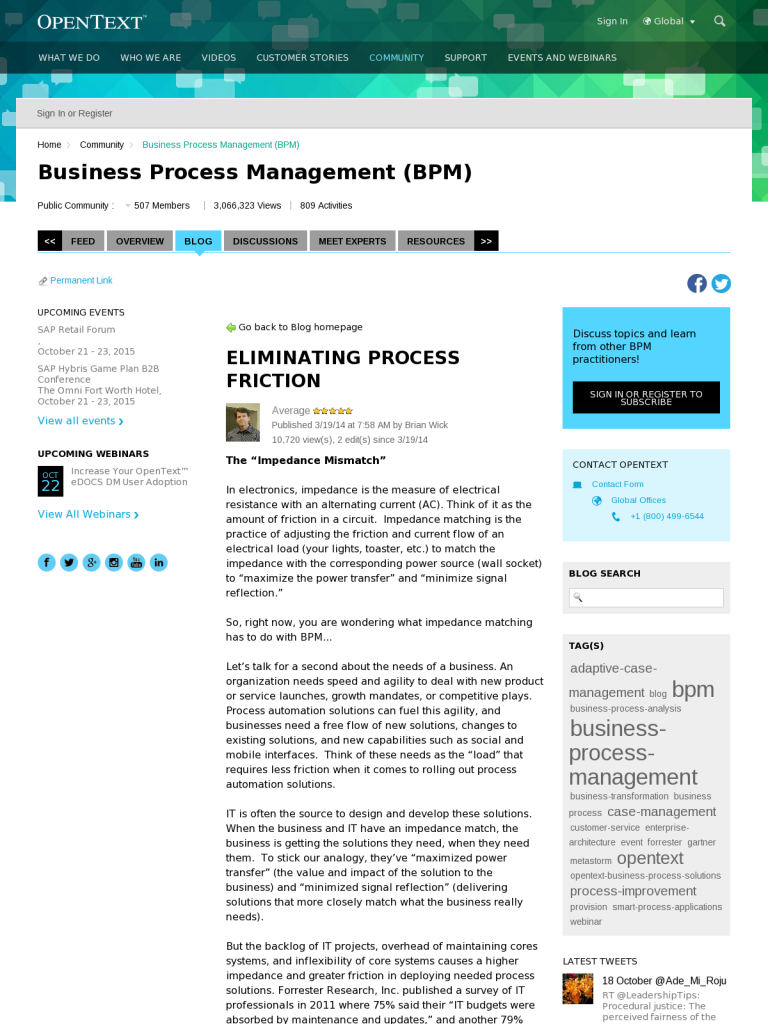Eliminating Process Friction
Blog: OpenText
Date:
Wed, 19 Mar 2014 07:58:00 GMT-05:00
From:
bwick
The “Impedance Mismatch”
In electronics, impedance is the measure of electrical
resistance with an alternating current (AC). Think of it as the amount
of friction in a circuit. Impedance matching is the practice of
adjusting the friction and current flow of an electrical load (your
lights, toaster, etc.) to match the impedance with the corresponding
power source (wall socket) to “maximize the power transfer” and
“minimize signal reflection.”
So, right now, you are
wondering what impedance matching has to do with BPM…
Let’s talk for a second about the needs of a business. An
organization needs speed and agility to deal with new product or
service launches, growth mandates, or competitive plays. Process
automation solutions can fuel this agility, and businesses need a free
flow of new solutions, changes to existing solutions, and new
capabilities such as social and mobile interfaces. Think of these
needs as the “load” that requires less friction when it comes to
rolling out process automation solutions.
IT is often the source to design and develop these solutions.
When the business and IT have an impedance match, the business is
getting the solutions they need, when they need them. To stick our
analogy, they’ve “maximized power transfer” (the value and impact of
the solution to the business) and “minimized signal reflection”
(delivering solutions that more closely match what the business really
needs).
But the backlog of IT projects, overhead of maintaining cores
systems, and inflexibility of core systems causes a higher impedance
and greater friction in deploying needed process solutions. Forrester
Research, Inc. published a survey of IT professionals in 2011 where
75% said their “IT budgets were absorbed by maintenance and updates,”
and another 79% said “inflexibility of core systems limits changes to
process.” This creates an impedance mismatch, and means while the
business needs new solutions in 1-4 months, IT groups are delivering
in 6 to 12 months. We’ve heard many times that when a solution takes
longer than 9 months to deploy, the needs of the business have changed
enough in that time that the solution is only a partial fit.
Introducing the OpenText Process Suite 10.5
The OpenText Process Suite, launched today, allows companies to
do impedance matching. It consists of a cloud-enabled platform, apps
and add-ons to ensure organizations can build the right solutions for
their particular needs. It is a flexible and agile solution that can
“wrap” core applications and create systems of engagement that touch
users inside and outside the organization with social and mobile
interfaces, content, process guidance, and collaboration in a way that
can adjust and change with their needs. Check out the diagram of the
Process Suite below.
The Process Component Library
A key part of the Process Suite 10.5 is the Process Component
Library (PCL), which is a pre-built set of services and composing
environment that allows organizations to develop various types of
solutions, from investigative, to service request, to incident
related, to process oriented solutions in literally weeks, instead of
months or years.
The out-of-the-box components that come with the PCL include
user interfaces, SLA management, task management, escalations,
document handling, packaged reporting, as well as many others, and are
assembled, not developed, in the composing environment to create a
solution. These are coarse grained components that include compound
functions, and are not single autonomous services. The Process
Component Library, along with other aspects of the Process Suite that
I will cover in subsequent blog postings, enable us to deliver
industry-leading speed and agility in deploying process automation and
case management solutions.
Think of the Process Suite, and the Process Component Library in
particular as the impedance matching of the flow of solutions from IT
to the needs of the business, with the result of increasing the “power
transfer” of their solutions to the business, and reducing the “power
reflection” by delivering solution that truly meet their rapidly
changing needs.
Want to learn more about the Process Component Library? Visit
us
here.
Leave a Comment
You must be logged in to post a comment.








